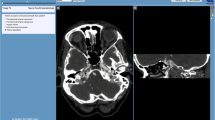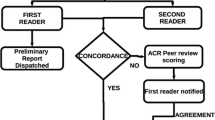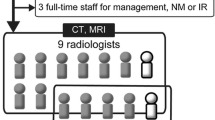Abstract
Purpose
To assess whether the modified reading system “Triage Reader” (TR) can improve the radiological reading work environment.
Materials and methods
This retrospective, single-center study analyzed two reading systems for 26,786 computed tomography and magnetic resonance imaging examinations. In the conventional system (January 1–May 31, 2016), all reading work was mostly completed within the day. In the TR system (January 1–May 31, 2017), a radiology resident (TR) first read every image immediately after the examination and tagged each examination according to actual image findings and clinical demands. Routine reading work was finished when all high-priority cases were completed. Low-priority cases were assessed the following day.
Results
When using the TR system, the mean reading number in the evening decreased (P = 0.009). The mean elapsed time to finalize report of case with actual urgent image finding shortened from 4.26 to 1.97 h (P < 0.0001). The mean number of cases experienced per resident increased from 5.4 to 28.7 (P < 0.001). Subjective evaluation revealed a significant improvement in “Reading efficiency” and “Contribution to clinical practice.”
Conclusion
Introduction of the TR system can improve the reading efficiency and quality, educational effect among residents by increasing the number of experienced cases and work satisfaction.








Similar content being viewed by others
References
Rubin GD. Computed tomography: revolutionizing the practice of medicine for 40 years. Radiology. 2014;273:S45–74.
Edelman PR. The history of MR imaging as seen through the pages of radiology. Radiology. 2014;273:S181–200.
Nakajima Y, Yamada K, Imamura K, Kobayashi K. Radiologist supply and workload: international comparison—Working Group of Japanese College of Radiology. Radiat Med. 2008;26:455–65.
Kumamaru KK, Machitori A, Koba R, Ijichi S, Nakajima Y, Aoki S. Global and Japanese regional variations in radiologist potential workload for computed tomography and magnetic resonance imaging examinations. Jpn J Radiol. 2018;36:273–81.
Hanna TN, Lamoureux C, Krupinski EA, Weber S, Johnson JO. Effect of shift, schedule, and volume on interpretive accuracy: a retrospective analysis of 2.9 million radiologic examinations. Radiology. 2018;287:205–12.
Ruutiainen AT, Durand DJ, Scanlon MH, Itri JN. Increased error rates in prelim reports issued by radiology residents working more than 10 consecutive hours overnight. Acad Radiol. 2013;20:305–11.
Kannappan A, Yip DT, Lodhia NA, Morton J, Lau JN. The effect of positive and negative verbal feedback on surgical skills performance and motivation. J Surg Educ. 2012;69:798–801.
Toode K, Routasalo P, Helminen M, Suominen T. Hospital nurses’ working conditions in relation to motivation and patient safety. Nurs Manag. 2015;21:31–41.
The council for the realization of work style reform. The action plan for the realization of work style reform. Available at: https://www.kantei.go.jp/jp/singi/hatarakikata/pdf/The_Action_Plan_for_the_Realization_of_Work_Style_Reform.pdf. Accessed June 1, 2018.
Yokota H, Goto M, Bamba C, Kiba M, Yamada K. Reading efficiency can be improve by minor modification of assigned duties; a pilot study on a small team of general radiologists. Jpn J Radiol. 2017;35:262–8.
Agrawal A, Koundinya DB, Raju JS, Kalyanpur A. Utility of contemporaneous dual read in the setting of emergency teleradiology reporting. Emerg Radiol. 2017;24:157–64.
Rådestad M, Lennquist Montán K, Rüter A, Castrén M, Svensson L, Gryth D, et al. Attitudes, towards and experience of the use of triage tags in major incidents: a mixed method study. Prehosp Disaster Med. 2016;31:376–85.
Svirsky I, Stoneking LR, Grall K, Berkman M, Stolz U, Shirazi F. Resident-initiated advanced triage effect on emergency department patient flow. J Emerg Med. 2013;45:746–51.
Japanese ministry of health, labor and welfare. Survey of physicians, dentists and pharmacists 2016. Available at: http://www.mhlw.go.jp/english/database/db-hss/dl/spdp_2016.pdf. Accessed June 1, 2018.
Kawase K, Nomura K, Tominaga R, Iwase H, Ogawa T, Shibasaki I, et al. Analysis of gender-based differences among surgeons in Japan: results of a survey conducted by the Japan Surgical society. Part. 2: personal life. Surg Today. 2018;48:308–19.
Owen JB, Chan WC, Sunshine JH, Shaffer KA. The sex ratio of American radiologists: comparison and implications by age, subspecialty, and type of practice. AJR Am J Roentogenol. 1995;165:1337–41.
Satiani B, Williams TE, Ellison EC. The impact of employment of part-time surgeons on the expected surgeon shortage. J Am Coll Surg. 2011;213:345–51.
Arleo EK, Parikh JR, Wolfman D, Gridley D, Bender C, Bluth E. Utilization of the family and medical leave act in radiology practices according to the commission on human resources workforce survey. J Am Coll Radiol. 2016;13:1440–6.
Brady AP. Measuring consultant radiologist workload: method and results from a national survey. Insights Imaging. 2011;2:247–60.
Acknowledgements
We whole heartedly thank our colleagues at the Division and Department of Radiology, Shinshu University Hospital, for their co-operation, and Mr. Tetsuya Ootsuki, PSP Corporation for technical support.
Author information
Authors and Affiliations
Corresponding author
Ethics declarations
Conflict of interest
The authors declare that they have no conflict of interest.
Ethical statement
This article does not contain any studies with human participants or animals performed by any of the authors.
About this article
Cite this article
Yamada, A., Okajima, Y., Yoshizawa, E. et al. Improvement in radiological reading efficiency and residents’ education and clinical contribution using the modified reading system “Triage Reader”. Jpn J Radiol 36, 649–660 (2018). https://doi.org/10.1007/s11604-018-0772-x
Received:
Accepted:
Published:
Issue Date:
DOI: https://doi.org/10.1007/s11604-018-0772-x




